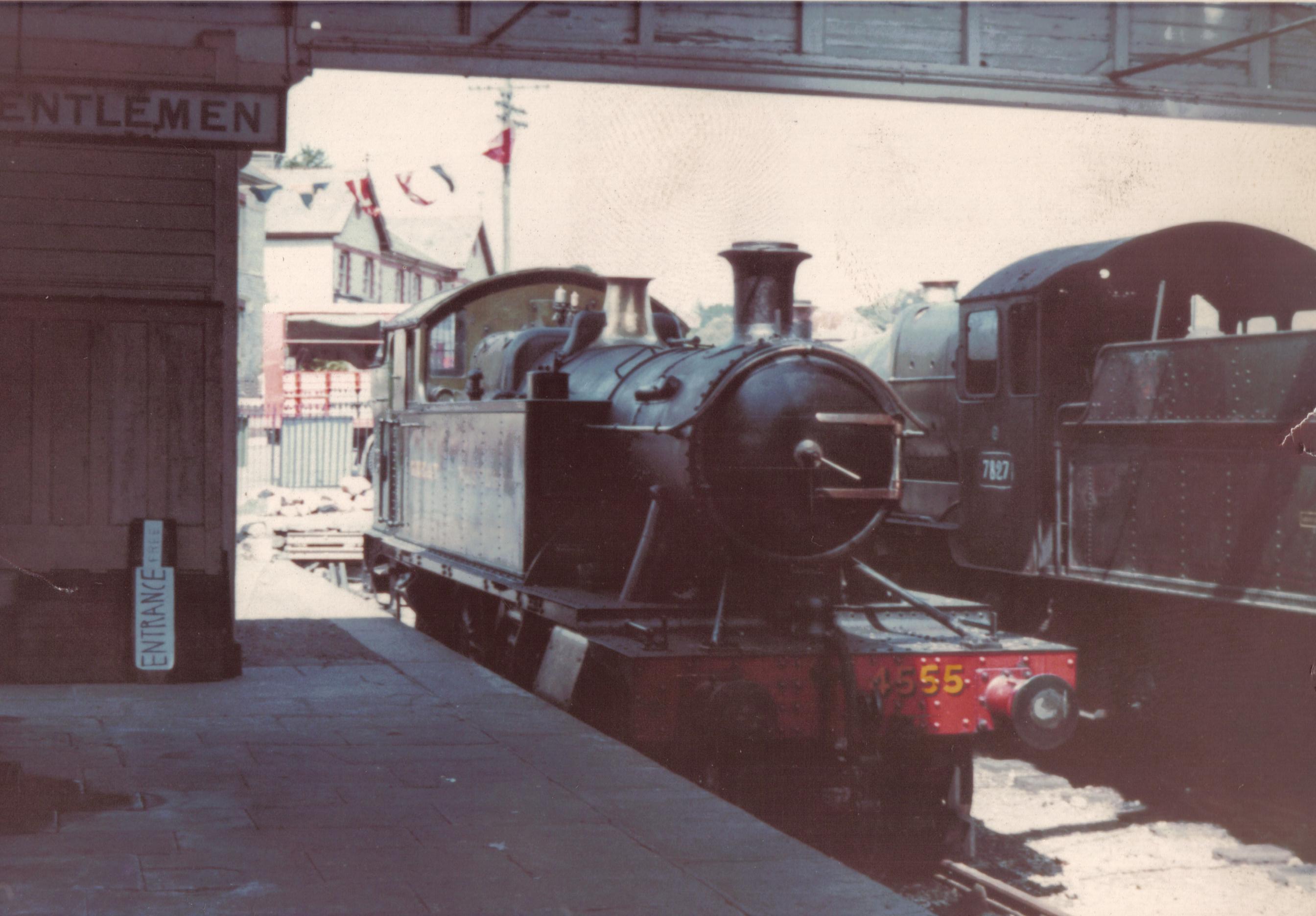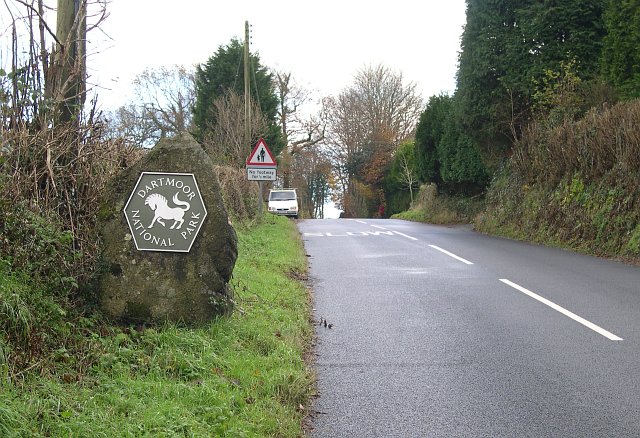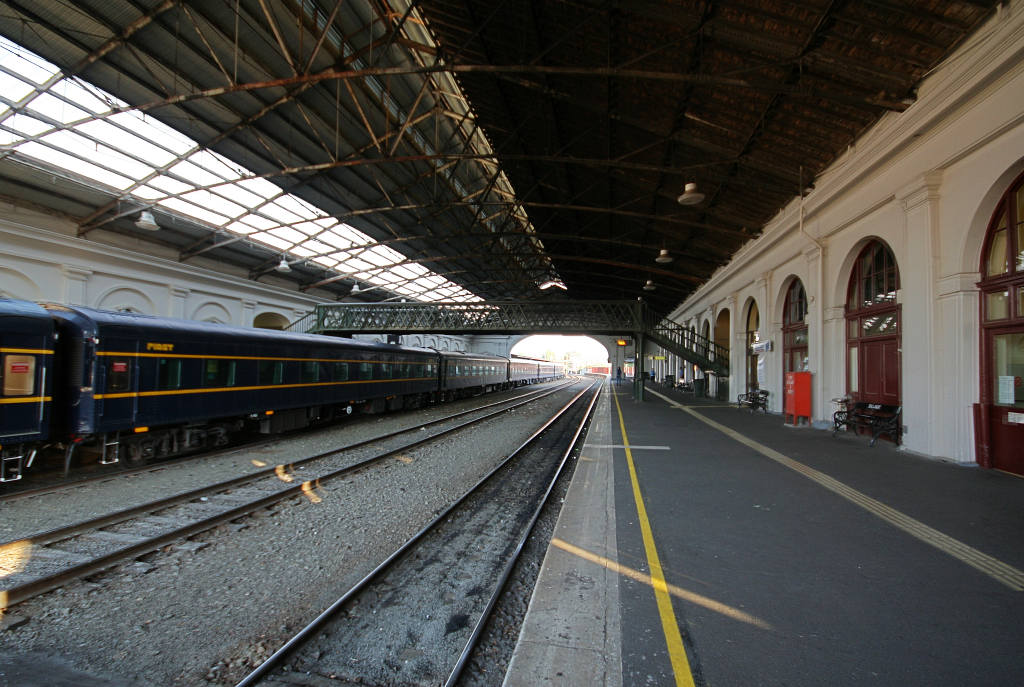|
Ashburton Railway Station
Ashburton railway station is a closed railway station situated in the town of Ashburton in Devon, England. It was the terminus of a branch line from Totnes. History Ashburton station, along with the rest of the branch from Totnes, was opened by the Buckfastleigh, Totnes and South Devon Railway on 1 May 1872. The railway was amalgamated into the Great Western Railway in 1897 and this in turn was nationalised into British Railways on 1 January 1948. The station closed to passengers in November 1958 although goods traffic on the line continued until 7 September 1962. The station was briefly re-opened by the Dart Valley Railway, a heritage railway, on 5 April 1969 following which occasional works trains operated but the station was closed finally in 1971 when the track bed between Ashburton and Buckfastleigh was needed for improvements to the A38 road. The South Devon Railway, a successor to the Dart Valley Railway, still operates the remainder of the branch between Totnes a ... [...More Info...] [...Related Items...] OR: [Wikipedia] [Google] [Baidu] |
Ashburton, Devon
Ashburton is a town on the south-southeastern edge of Dartmoor in Devon, England, adjacent to the A38. The town is 20 miles (32 km) northeast of Plymouth and 17 miles (27 km) southwest of Exeter. It was formerly important as a stannary town (a centre for the administration of tin-mining), and remains the largest town within the national park. Ashburton has five pubs within the centre of town and five restaurants/cafés. The town is also part of the electoral ward named ''Ashburton and Buckfastleigh'', the population of which at the 2011 census was 7,718. History The town's name derives from the Old English ''æsc-burna-tun'' meaning 'farm/settlement with a stream frequented by ash trees'. The name is recorded in the Domesday Book (1086) as ''Essebretone''. Ashburton was then the main town of the Parish of Ashburton, in Teignbridge Hundred. During the English Civil War, Ashburton was a temporary refuge for Royalist troops fleeing after their defeat by General Fairf ... [...More Info...] [...Related Items...] OR: [Wikipedia] [Google] [Baidu] |
A38 Road
The A38, parts of which are known as Devon Expressway, Bristol Road and Gloucester Road, Bristol, Gloucester Road, is a major A-class trunk road in England. The road runs from Bodmin in Cornwall to Mansfield in Nottinghamshire. It is long, making it the longest two-digit A road in England. It was formerly known as the ''Leeds–Exeter Trunk Road'', when this description also included the A61 road (Great Britain), A61. Before the opening of the M5 motorway in the 1960s and 1970s, the A38 formed the main "holiday route" from the Midlands to Somerset, Devon and Cornwall. Considerable lengths of the road in the West Midlands (region), West Midlands closely follow Roman roads, including part of Icknield Street. Between Worcester, England, Worcester and Birmingham the current A38 follows the line of a Saxon salt road; For most of the length of the M5 motorway, the A38 road runs alongside it as a single carriageway road. Route description Bodmin to Birmingham The road starts on t ... [...More Info...] [...Related Items...] OR: [Wikipedia] [Google] [Baidu] |
Railway Stations In Great Britain Opened In 1969
Rail transport (also known as train transport) is a means of transport that transfers passengers and goods on wheeled vehicles running on rails, which are incorporated in tracks. In contrast to road transport, where the vehicles run on a prepared flat surface, rail vehicles (rolling stock) are directionally guided by the tracks on which they run. Tracks usually consist of steel rails, installed on sleepers (ties) set in ballast, on which the rolling stock, usually fitted with metal wheels, moves. Other variations are also possible, such as "slab track", in which the rails are fastened to a concrete foundation resting on a prepared subsurface. Rolling stock in a rail transport system generally encounters lower frictional resistance than rubber-tyred road vehicles, so passenger and freight cars (carriages and wagons) can be coupled into longer trains. The operation is carried out by a railway company, providing transport between train stations or freight customer facili ... [...More Info...] [...Related Items...] OR: [Wikipedia] [Google] [Baidu] |
Railway Stations In Great Britain Closed In 1958
Rail transport (also known as train transport) is a means of transport that transfers passengers and goods on wheeled vehicles running on rails, which are incorporated in tracks. In contrast to road transport, where the vehicles run on a prepared flat surface, rail vehicles (rolling stock) are directionally guided by the tracks on which they run. Tracks usually consist of steel rails, installed on sleepers (ties) set in ballast, on which the rolling stock, usually fitted with metal wheels, moves. Other variations are also possible, such as "slab track", in which the rails are fastened to a concrete foundation resting on a prepared subsurface. Rolling stock in a rail transport system generally encounters lower frictional resistance than rubber-tyred road vehicles, so passenger and freight cars (carriages and wagons) can be coupled into longer trains. The operation is carried out by a railway company, providing transport between train stations or freight customer facil ... [...More Info...] [...Related Items...] OR: [Wikipedia] [Google] [Baidu] |
Railway Stations In Great Britain Opened In 1872
Rail transport (also known as train transport) is a means of transport that transfers passengers and goods on wheeled vehicles running on rails, which are incorporated in tracks. In contrast to road transport, where the vehicles run on a prepared flat surface, rail vehicles (rolling stock) are directionally guided by the tracks on which they run. Tracks usually consist of steel rails, installed on sleepers (ties) set in ballast, on which the rolling stock, usually fitted with metal wheels, moves. Other variations are also possible, such as "slab track", in which the rails are fastened to a concrete foundation resting on a prepared subsurface. Rolling stock in a rail transport system generally encounters lower frictional resistance than rubber-tyred road vehicles, so passenger and freight cars (carriages and wagons) can be coupled into longer trains. The operation is carried out by a railway company, providing transport between train stations or freight customer facilit ... [...More Info...] [...Related Items...] OR: [Wikipedia] [Google] [Baidu] |
Former Great Western Railway Stations
A former is an object, such as a template, gauge or cutting die, which is used to form something such as a boat's hull. Typically, a former gives shape to a structure that may have complex curvature. A former may become an integral part of the finished structure, as in an aircraft fuselage, or it may be removable, being using in the construction process and then discarded or re-used. Aircraft formers Formers are used in the construction of aircraft fuselage, of which a typical fuselage has a series from the nose to the empennage, typically perpendicular to the longitudinal axis of the aircraft. The primary purpose of formers is to establish the shape of the fuselage and reduce the column length of stringers to prevent instability. Formers are typically attached to longerons, which support the skin of the aircraft. The "former-and-longeron" technique (also called stations and stringers) was adopted from boat construction, and was typical of light aircraft built until the a ... [...More Info...] [...Related Items...] OR: [Wikipedia] [Google] [Baidu] |
Buckfastleigh Railway Station
Buckfastleigh railway station is situated on the South Devon Railway, a heritage railway in Devon, England. It serves the town of Buckfastleigh. History The station was opened by the Buckfastleigh, Totnes and South Devon Railway on 1 May 1872. The railway was amalgamated into the Great Western Railway in 1897 and this in turn was nationalised into British Railways on 1 January 1948. A camping coach was positioned here by the Western Region from 1956 to 1961. The station closed to passengers in November 1958 although goods traffic on the line continued until 10 September 1962. It was re-opened as the ''Dart Valley Railway'', a heritage railway, on 5 April 1969. The South Devon Railway Trust took over the running of the line on 1 January 1991. In 1971 Buckfastleigh became the terminus of the line when the route beyond the station was closed to allow improvements to the A38 road. Workshops have since been provided for restoring and repairing the locomotives and rolling stock us ... [...More Info...] [...Related Items...] OR: [Wikipedia] [Google] [Baidu] |
Teignbridge District Council
Teignbridge is a local government district in Devon, England. Its council is based in Newton Abbot. Other towns in the district include Ashburton, Buckfastleigh, Dawlish and Teignmouth. It is named for the old Teignbridge hundred. The district was formed on 1 April 1974, under the Local Government Act 1972, as a merger of the Ashburton, Buckfastleigh, Dawlish, Newton Abbot and Teignmouth urban district Urban district may refer to: * District * Urban area * Quarter (urban subdivision) * Neighbourhood Specific subdivisions in some countries: * Urban districts of Denmark * Urban districts of Germany * Urban district (Great Britain and Ireland) (hist ...s along with Newton Abbot Rural District and part of St Thomas Rural District. Politics Elections to the borough council are held every four years, with all of the 46 seats on the council being elected at each election. The council had been under no overall control since the 1983, until the Conservatives gained a majorit ... [...More Info...] [...Related Items...] OR: [Wikipedia] [Google] [Baidu] |
Dartmoor National Park Authority
The Dartmoor National Park Authority (DNPA) is a national park authority in England, legally responsible for Dartmoor in Devon. It came into existence in its present form in 1997, being preceded by a committee of Devon County Council (from 1951 to March 1974) and the Dartmoor National Park Committee from 1 April 1974. History Dartmoor, in the county of Devon, is 368 square miles (954 km2) in area. It was designated as one of the National Parks of England and Wales by statute in 1951; it has over 34,000 people living in it, and some 2.2 million people visited it in 2011. First incarnation For the first 23 years of its existence, Dartmoor National Park was administered by a special committee of Devon County Council,Mercer 2009, p. 326 the "Dartmoor Sub-Committee". During this time the major proposals dealt with by the committee included extensions of china clay workings and coniferous plantations (which did not take place); the erection of a television transmitting mast at No ... [...More Info...] [...Related Items...] OR: [Wikipedia] [Google] [Baidu] |
Goods Shed
A goods shed is a railway building designed for storing goods before or after carriage in a train. A typical goods shed will have a track running through it to allow goods wagons to be unloaded under cover, although sometimes they were built alongside a track with possibly just a canopy over the door. There will also be a door to move goods to or from road wagons and vans, this sometimes is parallel to the rail track, or sometimes on the side opposite the rail track. Inside the shed will generally be a platform and sometimes a small crane to allow easier loading and unloading of wagons. Double track Some goods sheds had more than one track. If one were not adjacent to the unloading platform then the method of working the second siding would be to first empty the wagons adjacent to the platform, and then open the doors on their far side to access those on the second track. Planks or portable bridges were normally provided for this purpose. Conversions When no longer require ... [...More Info...] [...Related Items...] OR: [Wikipedia] [Google] [Baidu] |
Train Shed
A train shed is a building adjacent to a station building where the tracks and platforms of a railway station are covered by a roof. It is also known as an overall roof. Its primary purpose is to store and protect from the elements train cars not in use, The first train shed was built in 1830 at Liverpool's Crown Street Station. The biggest train sheds were often built as an arch of glass and iron, while the smaller were built as normal pitched roofs. The train shed with the biggest single span ever built was that at the second Philadelphia Broad Street Station, built in 1891. Types of train shed Early wooden train sheds The earliest train sheds were wooden structures, often with unglazed openings to allow smoke and steam to escape. The oldest part of Bristol Temple Meads is a particularly fine – and large – example, designed by Isambard Kingdom Brunel with mock-hammerbeam roof. Surviving examples include: * Ashburton, Devon, England (station closed) *Bo'ness, Falki ... [...More Info...] [...Related Items...] OR: [Wikipedia] [Google] [Baidu] |






